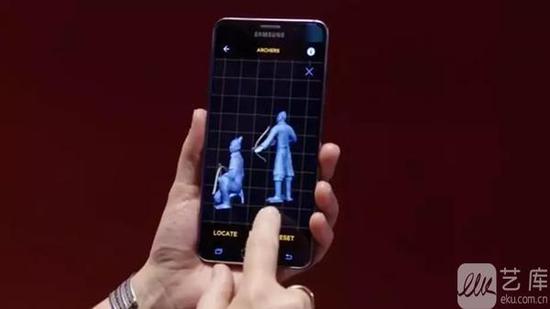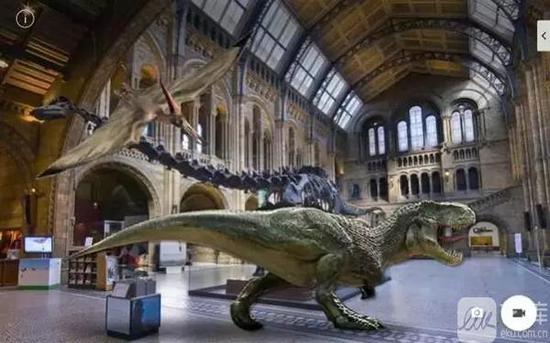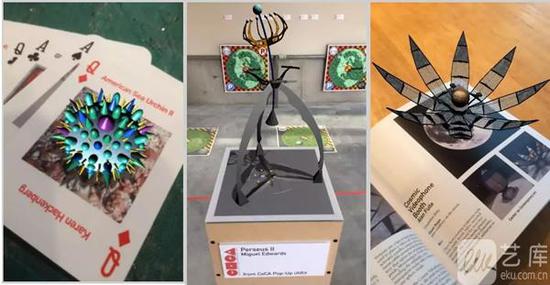Source: Art Library
With the popularization of the "new museum science" theory, the original knowledge of the museum is instilled, that is, through the display form of words and pictures, it further evolves into a collective participation, guiding the audience and welcoming more personal understanding and discussion. Every viewer is encouraged to be part of the experience and build an unformed picture together.
In practice, more and more museums use technology to optimize the experience of visiting. In addition to some of the educational devices typical of the mass-market era, such as large screens, posters, and audio guides, they have also tried some novel ways to enhance fun and personalized narratives.
Among them, AR technology (Augmented Reality) is considered to stimulate the strong sense of presence of the experience, and effectively trigger emotional reactions in the process of their learning, thus attracting a lot of museum attention.
Application of AR technology in museums
1 Franklin Institute

Audiences can use AR technology at the Franklin Institute's app to better understand the mysteries of Terracotta Warriors. This exhibition, presented in AR technology, illustrates how these sculptures, weapons and objects were made more than two thousand years ago. The Franklin Institute hopes to help the audience to better explore the mausoleum of Emperor Qin Shihuang, the emperor of China's first unified dynasty, through AR technology.
2 Catalonia Museum of Art

The Museu Nacional d'Art de Catalunya uses AR technology to not only allow visitors to “resurrect” dinosaurs, but also interact with dinosaurs: when you are near a virtual dinosaur, it looks bigger, you You can walk around it and watch it 360 degrees. When you get close to a virtual dinosaur, it will growl.
3 Seattle Center for Contemporary Art
The Seattle's Center on Contemporary Art selected 18 different 3D artists and created an AR-enhanced art gallery called "Pop-up (AR)t". Inspired by traditional three-dimensional books, the Seattle Center for Contemporary Art uses AR technology to make art on every page of the book appear in front of the audience in a three-dimensional way.

4 British Museum
A fun adventure game, “A Gift to Athena,” was launched at the Samsung Digital Discovery Centre at the British Museum. Visitors need to use AR-enabled mobile devices to scan specific exhibit objects and collect words and digital props to solve puzzles. Participants unlock the lock to the next story by unlocking a small mystery. Through this form, the participants receive knowledge of the relevant exhibits little by little during the learning process.
AR in the museum, how does the audience react? AR is in the museum, how does the audience react?
As a US startup that specializes in digital products for museums and other tourist attractions, Cuseum is deeply interested in how new technologies and methods affect the interaction and interaction of museums and tourist attractions with visitors. In the past few years, many changes have taken place in these interactions, and these changes have redefined how institutions such as museums view digital visits and the expectations of visitors.
Consumer expectations are growing and improving faster than ever before. As consumers experience new things faster, more interesting, and more personalized on their smartphones, their expectations for new technologies are growing.
In the recent wave of Augmented Reality (Augmented Reality), thanks to the promotion of Pokémon Go, Apple, Google, Facebook and Snap, museums and museum audiences also felt the impact of AR technology. The demand for AR technology in museums and many tourist attractions has also increased and has begun to be tried.
P&S Market Research's recently released market report on AR technology states that “the growth in this market is mainly attributable to the growing demand for AR technology in the tourism industry, including museums and other tourist attractions. In addition, Accenture found in a survey of more than 21,000 consumers in 2018 that they mainly wanted to use AR technology to "learn more about where they are visiting."
But at a more specific level, what information can the public learn about using AR technology and other immersive experiences in museums?
In order to measure the public's reaction to the museum's use of AR technology and other immersive technologies, the Museum conducted a site survey. The purpose of the study was to evaluate the impact of mobile technology (including AR technology) and how it affects the visitor experience. In this survey, participants were asked to use an AR-based app and then answer a series of questions about their experience.
A total of 103 visitors were surveyed, and almost all participants agreed that AR technology enhanced their experience with the museum.
More specific findings are as follows:
1 out of 10 participants said that mobile technology makes it easier to access information;
2 91% of participants said that AR technology is an exciting new way to get information;
3 87% of participants claim that AR technology enhances their experience and hope that all museums will be able to use this technology;
4 85% of participants said they would recommend this experience to friends.
In addition, the Library also asked participants to describe the experience in one word. Most of the respondents responded with “convenience”, “enhancement”, “fun” and “immersion”.
The survey results show that AR technology plays a huge role in promoting the mobile experience in the cultural field. Mobile devices will continue to be an important link between visitors and culture. Rather, smartphones will be the primary way for visitors to experience AR content in the future. The combination of digital tools (such as AR) and smartphones means that mobile phones will become a good helper for visitors to visit and learn in museums in the future. The Cabinet also said that they are looking for ways to further optimize this experience.
